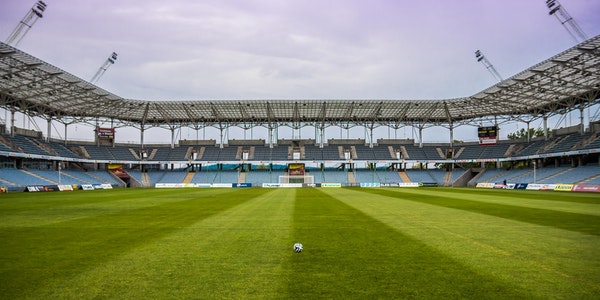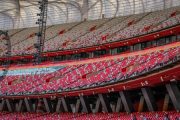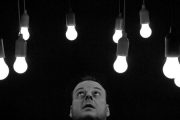IV. Challenges and Considerations
A. Initial investment costs
The initial investment costs for upgrading to LED lighting at stadiums can vary widely depending on factors such as the size of the venue, the scope of the lighting project, and the specific requirements of the facility. However, here are some potential cost considerations:
- LED Fixtures: The cost of LED lighting fixtures is a significant component of the initial investment. LED floodlights designed for sports stadiums typically have a higher price point compared to conventional lighting fixtures due to their specialized design and performance requirements.
- Installation Labor: The installation of LED lighting systems in stadiums often requires skilled labor, including electricians, lighting designers, and technicians. Labor costs can vary depending on factors such as the complexity of the installation process, accessibility of the venue, and local labor rates.
- Infrastructure Upgrades: In some cases, infrastructure upgrades may be necessary to support the installation of LED lighting systems. This could include electrical system upgrades, such as wiring, circuit modifications, or installation of new mounting structures to accommodate the LED fixtures.
- Control Systems: LED lighting systems often include advanced control options for dimming, zoning, and scheduling. The cost of control systems, such as lighting management software, hardware, and control panels, should be factored into the initial investment.
- Project Management: The cost of project management services, including planning, coordination, and oversight of the installation process, should also be considered. Effective project management ensures that the LED lighting upgrade is executed efficiently and meets the requirements of the stadium.
- Regulatory Compliance: Compliance with lighting standards and regulations may necessitate additional costs, such as obtaining permits or certifications for the LED lighting installation. It’s important to ensure that the lighting upgrade meets all relevant safety and performance requirements.
- Warranty and Maintenance: While LED fixtures generally have longer lifespans and lower maintenance requirements than conventional lighting systems, it’s important to budget for warranties and ongoing maintenance to ensure optimal performance and longevity of the lighting system.
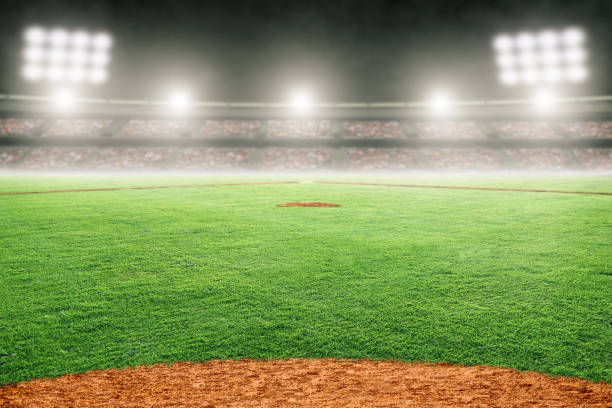 Overall, the initial investment costs for upgrading to LED lighting at stadiums can be significant, but the long-term benefits, including energy savings, reduced maintenance expenses, and improved lighting performance, often justify the investment. Additionally, potential rebates or incentives for energy-efficient upgrades may help offset some of the upfront costs associated with the LED lighting project.
Overall, the initial investment costs for upgrading to LED lighting at stadiums can be significant, but the long-term benefits, including energy savings, reduced maintenance expenses, and improved lighting performance, often justify the investment. Additionally, potential rebates or incentives for energy-efficient upgrades may help offset some of the upfront costs associated with the LED lighting project.
B. Maintenance requirements
Maintenance requirements for LED lighting at stadiums are generally lower compared to traditional lighting systems, but they still require periodic upkeep to ensure optimal performance and longevity. Here are some key maintenance considerations for LED lighting at stadiums:
- Cleaning: Regular cleaning of LED fixtures is essential to remove dust, dirt, and debris that can accumulate over time and reduce light output. This can typically be done with a soft cloth or brush and mild detergent solution. Cleaning should be performed at least annually or as needed based on environmental conditions.
- Inspections: Regular inspections of LED fixtures should be conducted to check for any signs of damage, corrosion, or wear. This includes inspecting electrical connections, mounting hardware, and protective enclosures. Any issues should be addressed promptly to prevent further damage or malfunction.
- Lamp Replacement: While LED fixtures have longer lifespans than traditional lamps, they will eventually reach the end of their useful life and require replacement. It’s important to follow manufacturer recommendations for lamp replacement intervals and procedures to ensure continued performance.
- Control System Maintenance: If the stadium’s LED lighting system includes advanced control options, such as dimming or zoning capabilities, regular maintenance of the control system may be necessary. This includes software updates, calibration, and troubleshooting of any issues with the control interface.
- Emergency Lighting Testing: In facilities where LED lighting is used for emergency lighting purposes, periodic testing and maintenance of emergency lighting systems are required to ensure compliance with safety regulations. This includes testing battery backup systems and verifying proper functionality of emergency luminaires.
- Environmental Considerations: LED fixtures are sensitive to environmental factors such as temperature, humidity, and moisture. It’s important to ensure that LED fixtures are installed in suitable locations and protected from exposure to extreme weather conditions or corrosive substances that could degrade performance.
- Warranty Coverage: Many LED lighting manufacturers offer warranties on their products, covering defects in materials and workmanship for a specified period. It’s important to keep records of warranty information and adhere to any maintenance requirements outlined in the warranty terms to maintain coverage.
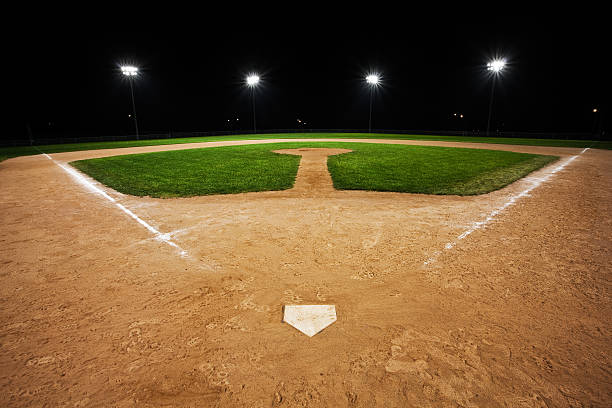
By implementing a proactive maintenance program for LED lighting at stadiums, facility managers can ensure optimal performance, energy efficiency, and longevity of the lighting system, ultimately maximizing the return on investment and enhancing the overall fan experience.
C. Potential issues with glare and light pollution
While LED lighting offers numerous benefits, including energy efficiency and improved visibility, there are potential issues with glare and light pollution that should be addressed, particularly in stadiums. Here are some potential issues and considerations:
- Glare: LED fixtures can produce glare, especially when they are improperly aimed or when viewed from certain angles. Glare can cause discomfort and reduced visibility for players, spectators, and nearby residents. Proper fixture placement, shielding, and the use of glare-reducing optics can help mitigate glare issues.
- Light Spillage: LED fixtures can produce light spillage beyond the intended area, resulting in light pollution. This can be problematic for nearby residents, wildlife, and astronomical observatories. Shielding and directing fixtures downward can help minimize light spillage and reduce light pollution.
- Color Temperature: The color temperature of LED lighting can affect visual comfort and perception. High color temperatures (cool white/blue light) may contribute to glare and discomfort, while lower color temperatures (warm white/yellow light) are generally more visually comfortable. Selecting appropriate color temperatures and using warm-up/cool-down features can help mitigate glare and enhance visual comfort.
- Flicker: LED lighting can exhibit flicker, which can be perceived as distracting or uncomfortable, especially at lower frequencies. Flicker can be caused by factors such as inconsistent power supply or poor dimming controls. Choosing LED fixtures with flicker-free technology and ensuring stable power sources can help reduce flicker issues.
- Sky Glow: Excessive upward light emission from LED fixtures can contribute to sky glow, a phenomenon where artificial light scatters in the atmosphere and brightens the night sky. This can obscure views of stars and celestial objects and disrupt ecosystems. Properly designed fixtures with full cutoff or shielded designs can minimize sky glow and preserve dark skies.
- Regulatory Compliance: LED lighting installations must comply with local regulations and lighting standards to mitigate glare and light pollution. This may include requirements for fixture shielding, light trespass, and maximum allowable light levels. Compliance with regulatory requirements helps ensure responsible and sustainable lighting practices.
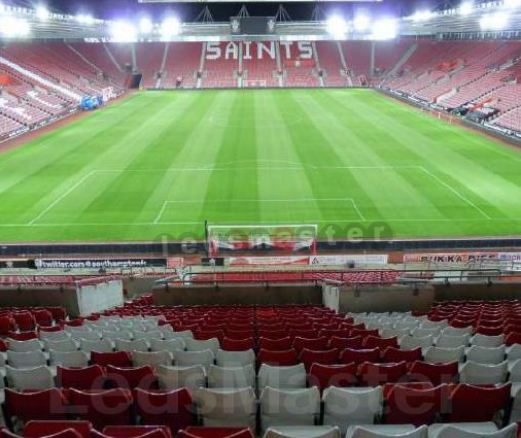
By addressing these potential issues with glare and light pollution through proper fixture selection, design, and installation, stadiums can minimize negative impacts on surrounding communities and the environment while maximizing the benefits of LED lighting for visibility, energy efficiency, and performance. Additionally, ongoing monitoring and adjustments can help maintain optimal lighting conditions over time.
V. Future Trends in LED Sports Lighting
A. Continued innovation in LED technology
Continued innovation in LED technology is driving advancements across various industries, including sports lighting. Here are some key areas of innovation in LED technology:
- Efficiency Improvements: Ongoing research and development efforts are focused on improving the efficiency of LED chips and luminaires. This includes advancements in materials science, device architecture, and manufacturing processes to achieve higher efficacy and lower power consumption.
- Miniaturization: Advances in LED chip design and packaging technology have led to smaller, more compact LEDs with higher power densities. This allows for more precise control over light distribution and enables the development of innovative lighting fixtures for sports stadiums with reduced form factors and increased versatility.
- Smart Lighting Systems: Integration of LED lighting with smart controls and IoT (Internet of Things) platforms enables advanced functionality such as remote monitoring, automated scheduling, and adaptive lighting strategies. Smart lighting systems optimize energy usage, enhance user experience, and enable dynamic lighting effects for special events and entertainment.
- Color Tunability: LED technology enables precise control over color temperature and spectral output, allowing for tunable white light and dynamic color-changing capabilities. This flexibility enables stadiums to create customized lighting schemes for different sports, events, and branding opportunities.
- Advanced Optics: Innovations in optical design, including microstructures, lenses, and reflectors, optimize light distribution and reduce glare while maximizing efficiency. Advanced optics improve uniformity, minimize light spillage, and enhance visual comfort for players and spectators.
- Human-Centric Lighting: Human-centric lighting (HCL) leverages LED technology to mimic natural daylight patterns and support human health and well-being. HCL systems adjust color temperature and intensity throughout the day to synchronize with circadian rhythms, promote alertness, and improve performance.
- Energy Harvesting: Integration of LED lighting with energy harvesting technologies, such as solar panels and kinetic energy systems, enables off-grid or self-sustaining lighting solutions for outdoor sports facilities. Energy harvesting reduces reliance on grid electricity and enhances sustainability.
- Material Innovations: Advancements in phosphor materials, encapsulants, and heat dissipation technologies improve LED reliability, lifespan, and performance under challenging environmental conditions. These material innovations enhance durability and reduce maintenance requirements for sports lighting installations.
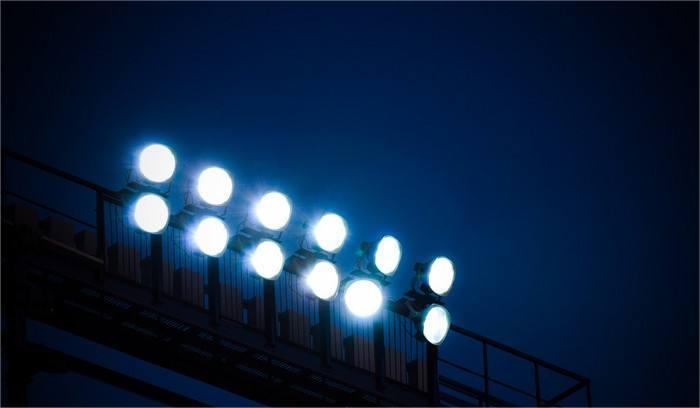
Overall, continued innovation in LED technology is driving the evolution of sports lighting systems, enabling energy-efficient, customizable, and connected lighting solutions that enhance visibility, performance, and the overall spectator experience in stadiums.
B. Integration with smart stadium systems
Integration with smart stadium systems is a significant trend in the evolution of sports lighting, particularly with the adoption of LED technology. Here’s how LED lighting integrates with smart stadium systems:
- IoT Connectivity: LED lighting fixtures can be equipped with IoT (Internet of Things) connectivity, enabling them to communicate with other smart devices and systems within the stadium. This connectivity allows for centralized control and monitoring of lighting operations through a smart stadium management platform.
- Centralized Control: LED lighting systems can be integrated into a central control system that manages various stadium operations, including lighting, HVAC, security, and audiovisual systems. Stadium operators can use this centralized platform to adjust lighting levels, schedule lighting sequences, and monitor energy usage in real-time.
- (To Be Continued)

